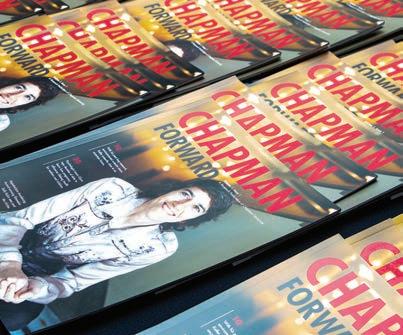
5 minute read
CHAPMAN FORWARD
RESEARCH THE YEAR IN
It’s been another banner year for research and creative activity at Chapman University. Milestones abound – from the University’s elevation to R2 status, to the offi cial launch of the Fowler School of Engineering; from biochemistry major and cancer researcher Vidal Arroyo ’19 earning Chapman’s fi rst Rhodes Scholarship, to the Brain Institute building new partnerships as it considers age-old questions of consciousness and free will. Here’s a capsule look at some of Chapman’s recent achievements.
Advertisement
Brain Institute Leads a Global Project This spring, the Institute for Interdisciplinary Brain and Behavioral Sciences (The Brain Institute) offi cially opened its doors. Validated by more than $7 million in funding, the Brain Institute is at the center of a global research project involving 17 universities, including Harvard, Yale, NYU, Duke, UCLA and University College London. In March, the Brain Institute hosted the second International Conference on the Neuroscience of Free Will, which drew 90 researchers from 40 universities.
$21.3 MILLION


Chapman is among the top universities in the country, according to the latest rankings from U.S. News & World Report. For the fi rst time, Chapman is ranked as a top-tier institution, an indication of its rising reputation, student profi le, world-class faculty and growing research programs. Chapman is No. 125 in the National Universities group, a category that includes 399 of the leading private and public research universities across the U.S. Th e inaugural issue of Chapman Forward magazine earned an International Circle of Excellence Award from the Council for Advancement and Support of Education (CASE). ? DID YOU KNOW? CU Elevated to R2 Status Last fall, Chapman earned an R2 designation in the update of the Carnegie Classifi cation of Institutions of Higher Education. Achieving R2 status, or high research activity, places Chapman in the company of just 130 national universities. “This classifi cation demonstrates our commitment to connecting our students to professors who are also cutting-edge researchers.” Chapman Provost Glenn Pfeiffer, Ph.D. Research Awards Rise Funding support from outside sponsors such as federal agencies and nonprofi t foundations continues to validate the growing impact of research at Chapman. During the most recent fi scal year, research awards totaled $21.3 million, representing an increase of 107 percent over the previous year. Since 2016, the fi gure has more than quadrupled. 2 CHAPMAN FORWARD
NOTES FROM THE FIELD
THE PLUCKY DUCKLING
Confounding nature and researchers, adoptive loon parents take a resilient little mallard under their wings.
BY STEPHANIE HOUSE

Since the duckling has imprinted on loons, there could be some confusion when it “goes back to being a mallard,” says Chapman biologist Walter Piper, who has studied the behavior of loons for 27 years. Photos and video of the mallard duckling being raised by loon parents have been shared widely, making the unlikely family a media sensation. Photo by Linda Grenzer.

In a story worthy of Hans Christian Andersen, a pair of chickless loons have adopted an orphaned mallard duckling, puzzling even experienced researchers. Chapman University biologist Walter Piper has studied loons for 27 years, and he’s astonished. “No one’s ever seen this type of foster family before,” says Piper, Ph.D., who leads the Loon Project, which since 1993 has tracked and studied the migratory birds on more than 200 lakes in northern Wisconsin. His research has been supported by the National Science Foundation. Th e unlikely adoption was fi rst noticed in June by Loon Project volunteers, who closely monitor nests for signs of chicks. In this case, cracked eggshells led to the discovery that a mallard duckling had been adopted by loons whose own chick had died. Loons oft en adopt orphaned chicks of their own species, and there have been cases of loons taking in ducks such as spectacled eiders and goldeneyes, which exhibit behaviors similar to those of loons. But never mallards. Photos and video of the unlikely family quickly spread on the Web, making the parents and their chick multimedia darlings. Piper has been interviewed by reporters from TV networks, newspapers and online sites. “Th is discovery is fascinating because it is a ‘natural experiment’ that allows us to see how one species of bird responds when it is placed under the care of another, very diff erent species,” Piper says. Typically loons and mallards don’t get along. In fact, loons sometimes attack and kill mallard ducklings. Th e two species don’t even share habits. While loons dive deep into lakes to forage for food, mallards feed by skimming the water’s surface. But this mallard duckling mimics Mom and Dad, earning the nickname “Th e Amazing Diving Duckling” as he reaches loon-like depths. He even eats fi sh – something a normal mallard duckling would never do. “Th is is a dramatic natural demonstration of behavioral fl exibility or malleability in an animal,” Piper says in a National Audubon Society article. As the little mallard matures, it’s likely he will eventually fi nd his own kind and assimilate, Piper says. However, since this duck imprinted on loons, there could be some confusion when he “goes back to being a mallard,” Piper adds. It’s possible the mallard might even try to mate with loons. “It would be very surprising if this duck were to form a notion that a loon was a suitable mate, but your guess is as good as mine,” Piper said in the Audubon piece. Meanwhile, Loon Project participants are eagerly documenting each new phase in the life of a mallard that clearly has imprinted on more than his parents. “I never wanted to fall in love with this duckling,” Piper writes on the Loon Project blog. “I thought that Daff y and Donald had ruined ducks for me forever. But this little guy’s plucky adaptability might just turn me around.”







